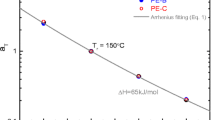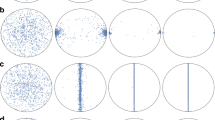Abstract
The behavior of short glass fiber–polypropylene suspensions in extensional flow was investigated using three different commercial instruments: the SER wind-up drums geometry (Extensional Rheology System) with a strain-controlled rotational rheometer, a Meissner-type rheometer (RME), and the Rheotens. Results from uniaxial tensile testing have been compared with data previously obtained using a planar slit die with a hyperbolic entrance. The effect of three initial fiber orientations was investigated: planar random, fully aligned in the stretching flow direction and perpendicular to it. The elongational viscosity increased with fiber content and was larger for fibers initially oriented in the stretching direction. The behavior at low elongational rates showed differences among the various experimental setups, which are partly explained by preshearing history and nonhomogenous strain rates. However, at moderate and high rates, the results are comparable, and the behavior is strain thinning. Finally, a new constitutive equation for fibers suspended into a fluid obeying the Carreau model is used to predict the elongational viscosity, and the predictions are in good agreement with the experimental data.











Similar content being viewed by others
References
Advani SG, Tucker CL (1987) The use of tensors to describe and predict fiber orientation in short fiber composites. J Rheol 31:751–784
Attanasio A, Bernini U, Galloppe P, Segre G (1972) Significance of viscosity measurement in macroscopic suspensions of elongated particles. Trans Soc Rheol 16:147–154
Ausias G, Agassant JF, Vincent M, Lafleur PG, Lavoie PA, Carreau PJ (1992) Rheology of short glass-fiber reinforced polypropylene. J Rheol 36:525–542
Batchelor GK (1971) The stress generated in a non-dilute suspension of elongated particles by pure straining motion. J Fluid Mech 46:813–829
Binding DM (1988) An approximate analysis for contraction and converging flows. J Non-Newton Fluid Mech 27:173–189
Bird RB, Curtiss CF, Armstrong RC, Hassager O (1987) Dynamics of polymeric liquids. In: Kinetic theory, vol 2. Wiley, New York
Carreau PJ, De Kee D, Chhabra RP (1997) Rheology of polymeric systems: principles and applications. Hanser, Munich
Chan Y, White JL, Oyanagi Y (1978) A fundamental study of the rheological properties of glass-fiber-reinforced polyethylene and polystyrene melts. J Rheol 22:507–524
Creasy TS, Advani SG (1997) A model long-discontinuous-fiber filled thermoplastic melt in extensional flow. J Non-Newton Fluid Mech 73:261–278
Creasy TS, Advani SG, Okine RK (1996a) Non-linear response of a long, discontinuous fiber/melt system in elongational flows. Rheol Acta 35:347–355
Creasy TS, Advani SG, Okine RK (1996b) Transient rheological behavior of a long discontinuous fiber-melt system. J Rheol 40:497–519
Crowson RJ, Folkes MJ (1980) Rheology of short glass fiber-reinforced thermoplastics and its application to injection molding. II. The effect of material parameters. Polym Eng Sci 20:934–940
Dinh SM, Armstrong RC (1984) A rheological equation of state for semiconcentrated fiber suspensions. J Rheol 28:207–227
Doi M, Edwards SF (1978a) Dynamics of rod-like macromolecules in concentrated solution. Part 1. J Chem Soc Faraday Trans 2(74):560–570
Doi M, Edwards SF (1978b) Dynamics of rod-like macromolecules in concentrated solution. Part 2. J Chem Soc Faraday Trans 2(74):918–932
Doi M, Edwards SF (1986) The rheology of polymer dynamics. Oxford Science Publications, New York
Férec J, Heniche M, Heuzey MC, Ausias G, Carreau PJ (2008) Numerical solution of the Fokker-Planck equation for fiber suspensions: application to the Folgar-Tucker-Lipscomb model. J Non-Newton Fluid Mech 155:20–29
Folgar FP, Tucker CL (1984) Orientation behavior of fibers in concentrated suspensions. J Reinf Plast Compos 3:98–119
Goddard JD (1976) The stress field of slender particles oriented by a non-Newtonian extensional flow. J Fluid Mech 78:177–206
Jeffery GB (1922) The motion of ellipsoidal particles immersed in a viscous fluid. Proc Roy Soc London Ser A 102:161–179
Kamal MR, Mutel AT (1989) The prediction of flow and orientation behavior of short fiber reinforced melts in simple flow systems. Polym Compos 10:337–343
Kamal MR, Mutel TA, Utracki LA (1984) Elongational behavior of short glass fiber reinforced polypropylene melts. Polym Compos 5:289–298
Kobayashi M, Takahashi T, Takimoto J, Koyama K (1995) Flow-induced whisker orientation and viscosity for molten composite systems in a uniaxial elongational flow field. Polymer 36:3927–3933
Laun HM (1984) Orientation effects and rheology of short glass fiber-reinforced thermoplastics. Coll Polym Sci 262:257–269
Lin G-G, Hu M-C (1997) Measurement of elongation viscosity for polymer melts by fiber spinning. Adv Polym Tech 16:199–207
Lipscomb GG, Denn MM, Hur DU, Boger DV (1988) The flow of fiber suspensions in complex geometries. J Non-Newton Fluid Mech 26:297–325
Lubansky AS, Boger DV, Cooper-White JJ (2005) Batchelor’s theory extended to elongated cylindrical or ellipsoidal particles. J Non-Newton Fluid Mech 130:57–61
Metzner AB (1985) Rheology of suspensions in polymeric liquids. J Rheol 29:739–775
Mewis J, Metzner AB (1974) The rheological properties of suspensions of fibres in Newtonian fluids subjected to extensional deformations. J Fluid Mech 62:593–600
Mobuchon C, Carreau PJ, Heuzey MC, Sepehr M, Ausias G (2005) Shear and extensional properties of short glass fiber reinforced polypropylene. Polym Compos 26:247–263
Mongruel A, Cloitre M (2003) Axisymmetric orifice flow for measuring the elongational viscosity of semi-rigid polymer solutions. J Non-Newton Fluid Mech 110:27–43
Ooi YW, Sridhar T (2004) Resistance to uniaxial extensional flow of fibre suspensions. Rheol Acta 43:223–231
Petrie CJS (1999) The rheology of fibre suspensions. J Non-Newton Fluid Mech 87:369–402
Poslinski AJ, Ryan ME, Gupta RK, Seshadri SG, Frechette FJ (1988) Rheological behavior of filled polymeric systems I. Yield stress and shear-thinning effects. J Rheol 32:703–735
Ramazani A, Ait-Kadi A, Grmela M (2001) Rheology of fiber suspensions in viscoelastic media: experiments and model predictions. J Rheol 45:945–962
Schweizer T (2000) The uniaxial elongational rheometer RME—six years of experience. Rheol Acta 39:428–443
Sentmanat ML (2004) Miniature universal testing platform: from extensional melt rheology to solid-state deformation behavior. Rheol Acta 43:657–669
Sentmanat ML, Wang BN, McKinley GH (2005) Measuring the transient extensional rheology of polyethylene melts using the SER universal testing platform. J Rheol 49:585–606
Sepehr M, Ausias G, Carreau PJ (2004a) Rheological properties of short fiber filled polypropylene in transient shear flow. J Non-Newton Fluid Mech 123:19–32
Sepehr M, Carreau PJ, Moan M, Ausias G (2004b) Rheological properties of short fiber model suspensions. J Rheol 48:1023–1048
Souloumiac B, Vincent M (1998) Steady shear viscosity of short fibre suspensions in thermoplastics. Rheol Acta 37:289–298
Takahashi T, Takimoto J-I, Koyama K (1999) Uniaxial elongational viscosity of various molten polymer composites. Polym Compos 20:357–366
Thomasset J, Carreau PJ, Sanschagrin B, Ausias G (2005) Rheological properties of long glass fiber filled polypropylene. J Non-Newton Fluid Mech 125:25–34
Wagner MH, Bernnat A, Schulze V (1998) The rheology of the rheotens test. J Rheol 42:917–928
Wagner AH, Kalyon DM, Yazici R, Fiske TJ (2003) Uniaxial extensional flow behavior of a glass fiber-filled engineering plastic. J Reinf Plast Compos 22:327–337
Weinberger CB, Goddard JD (1974) Extensional flow behavior of polymer solutions and particle suspensions in a spinning motion. Int J Multiph Flow 1:465–486
Zhang W, Komoto S, Yamane H, Takahashi M, White JL (2001) Biaxial extensional flow behavior and fiber dispersion and orientation in short glass fiber filled polypropylene melts. J Soc Rheol Japan 29:111–120
Acknowledgements
This work was supported by the France-Québec collaboration program and funded by NSERC (Natural Science and Engineering Research Council of Canada—CIAM program), and by CONACYT (CIAM 51837) and SIP-IPN (20060296-20070642) in México. The authors wish to thank Dr. G. Krotkine from Basell who kindly provided the materials used in this study. We are also thankful to Ms. M.J. Ramirez-Moreno, from the Instituto Politécnico Nacional in Mexico City (Mexico) for the Rheotens measurements, to Mr. J.R. R.-Siffert, from Pontificia Universidade Católica-RJ in Rio de Janeiro (Brazil) for helpful sample preparation and preliminary tests, and to Christophe Mobuchon for the Binding analysis of the slit die data. Finally, the authors wish to acknowledge Dr. S. Dagreou and Dr. F. Leonardi at the University de Pau for the use of their RME.
Author information
Authors and Affiliations
Corresponding author
Appendices
Appendix 1
From the Dinh and Armstrong expression (Dinh and Armstrong 1984), the normal stress components are defined as:
According to the definition of Eq. 13, the transient elongational viscosity is written as:
Thanks to the equation of change for ψ, the fourth-order orientation tensor components are determined easily and the transient extensional viscosity is expressed without the need of a closure approximation for the fourth-order tensor.
Appendix 2
Equation 11 is used to express the steady extensional flow in the case where fibers are perfectly aligned in the principal stretching direction (x 1). Therefore, the orientation distribution function is simply a Dirac function:
Then the normal stress components are given by:
Consequently, the steady elongational viscosity is written as:
where λ m , m, μ 2, and λ f are used as fitting parameters.
Appendix 3
In order to achieve model predictions for the transient elongational viscosity, initial orientation functions have to be defined to take into account the three initial fiber orientations of Fig. 1. Following Advani and Tucker (1987), highly oriented states (i.e., parallel and perpendicular to the stretching direction) are obtained by a nonconventional distribution function having the form:
where \(K_{\bot }\) and K _ are constants that satisfy the normalization condition. Both p and q are taken equal to 60 to give aligned fiber orientation. The planar random orientation state (not to be confused with a biplanar orientation obtained by adding Eqs. 25 and 26 with respect to the normalization condition) is reached with the following distribution function:
where δ is the Dirac function and K x is introduced to respect the normalization condition.
Rights and permissions
About this article
Cite this article
Férec, J., Heuzey, MC., Pérez-González, J. et al. Investigation of the rheological properties of short glass fiber-filled polypropylene in extensional flow. Rheol Acta 48, 59–72 (2009). https://doi.org/10.1007/s00397-008-0309-9
Received:
Revised:
Accepted:
Published:
Issue Date:
DOI: https://doi.org/10.1007/s00397-008-0309-9




